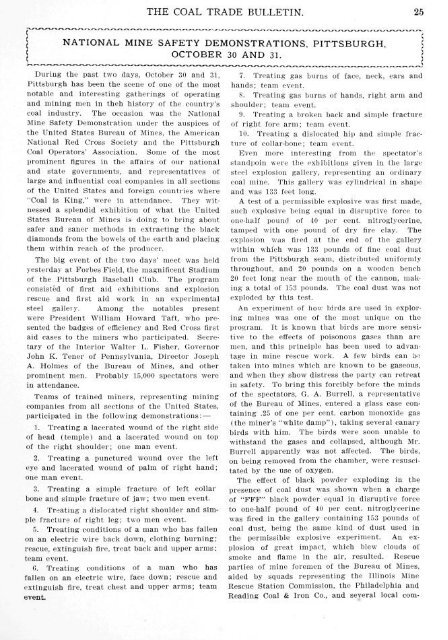u,.:- • - Clpdigital.org
u,.:- • - Clpdigital.org
u,.:- • - Clpdigital.org
You also want an ePaper? Increase the reach of your titles
YUMPU automatically turns print PDFs into web optimized ePapers that Google loves.
THE COAL TRADE BULLETIN. 25<br />
NATIONAL MINE SAFETY DEMONSTRATIONS,<br />
OCTOBER 30 AND 31.<br />
During the past two days, October 30 and 31,<br />
Pittsburgh has been the scene of one of the most<br />
notable and interesting gatherings of operating<br />
and mining men in theh history of the country's<br />
coal industry. The occasion was the National<br />
Mine Safety Demonstration under the auspices of<br />
the United States Bureau of Mines, the American<br />
National Red Cross Society and the Pittsburgh<br />
Coal Operators' Association. Some of the most<br />
prominent figures in the affairs of our national<br />
and state governments, and representatives of<br />
large and influential coal companies in all sections<br />
of the United States and foreign countries where<br />
"Coal is King," were in attendance. They witnessed<br />
a splendid exhibition of what the United<br />
States Bureau of Mines is doing to bring about<br />
safer and saner methods in extracting the black<br />
diamonds from the bowels of the earth and placing<br />
them within reach of the producer.<br />
The big event of the two days' meet was held<br />
yesterday at Forbes Field, the magnificent Stadium<br />
of the Pittsburgh Baseball Club. The program<br />
consisted of first aid exhibitions and explosion<br />
rescue and first aid work in an experimental<br />
steel gallery. Among the notables present<br />
were President William Howard Taft, who presented<br />
the badges of efficiency and Red Cross first<br />
aid cases to the miners who participated. Secretary<br />
of the Interior Walter L. Fisher, Governor<br />
John K. Tener of Pennsylvania, Director Joseph<br />
A. Holmes of the Bureau of Mines, and other<br />
prominent men. Probably 15,000 spectators were<br />
in attendance.<br />
Teams of trained miners, representing mining<br />
companies from all sections of the United States,<br />
participated in the following demonstrations: —<br />
1. Treating a lacerated wound of the right side<br />
of head (temple) and a lacerated wound on top<br />
of the right shoulder; one man event.<br />
2. Treating a punctured wound over the left<br />
eye and lacerated wound of palm of right hand;<br />
one man event.<br />
3. Treating a simple fracture of left collar<br />
bone and simple fracture of jaw; two men event.<br />
4. Treating a dislocated right shoulder and simple<br />
fracture of right leg; two men event.<br />
5. Treating conditions of a man who has fallen<br />
on an electric wire back down, clothing burning;<br />
rescue, extinguish fire, treat back and upper arms:<br />
team event.<br />
(1. Treating conditions of a man who has<br />
fallen on an electric wire, face down; rescue and<br />
extinguish fire, treat chest and upper arms; team<br />
event.<br />
PITTSBURGH,<br />
7. Treating gas burns of face, neck, ears and<br />
hands; team event.<br />
8. Treating gas burns of hands, right arm and<br />
shoulder; team event.<br />
9. Treating a broken back and simple fracture<br />
of right fore arm; team event.<br />
10. Treating a dislocated hip and simple fracture<br />
of collar-bone; team event.<br />
Even more interesting from the spectator's<br />
standpoin were the exhibitions given in the large<br />
steel explosion gallery, representing an ordinary<br />
coal mine. This gallery was cylindrical in shape<br />
and was 133 feet long.<br />
A test of a permissible explosive was first made,<br />
such explosive being equal in disruptive force to<br />
one-half pound of 40 per cent, nitroglycerine,<br />
tamped with one pound of dry fire clay. The<br />
explosion was fired at the end of the gallery<br />
within which was 133 pounds of fine coal dust<br />
from the Pittsburgh seam, distributed uniformly<br />
throughout, and 20 pounds on a wooden bench<br />
20 feet long near the mouth of the cannon, making<br />
a total of 153 pounds. The coal dust was not<br />
exploded by this test.<br />
An experiment of bow birds are used in exploring<br />
mines was one of the most unique on the<br />
program. It is known that birds are more sensitive<br />
to the effects of poisonous gases than are<br />
men, and this principle has been used to advantage<br />
in mine rescue work. A few birds can be<br />
taken into mines which are known to be gaseous,<br />
and when they show distress the party can retreat<br />
in safety. To bring this forcibly before the minds<br />
of the spectators, G. A. Burrell, a representative<br />
of the Bureau of Mines, entered a glass case containing<br />
.25 of one per cent, carbon monoxide gas<br />
(the miner's "white damp"), taking several canary<br />
birds with him. The birds were soon unable to<br />
withstand the gases and collapsed, although Mr.<br />
Burrell apparently was not affected. The birds,<br />
on being removed from the chamber, were resuscitated<br />
by the use of oxygen.<br />
The effect of black powder exploding in the<br />
presence of coal dust was shown when a charge<br />
of "FFP" black powder equal in disruptive force<br />
to one-half pound of 40 per cent, nitroglycerine<br />
was fired in the gallery containing 153 pounds of<br />
coal dust, being the same kind of dust used in<br />
the permissible explosive experiment. An explosion<br />
of great impact, which blew clouds of<br />
smoke and flame in the air, resulted. Rescue<br />
parties of mine foremen of the Bureau of Mines,<br />
aided by squads representing the Illinois Mine<br />
Rescue Station Commission, the Philadelphia and<br />
Reading Coal & Iron Co., and several local com-
















